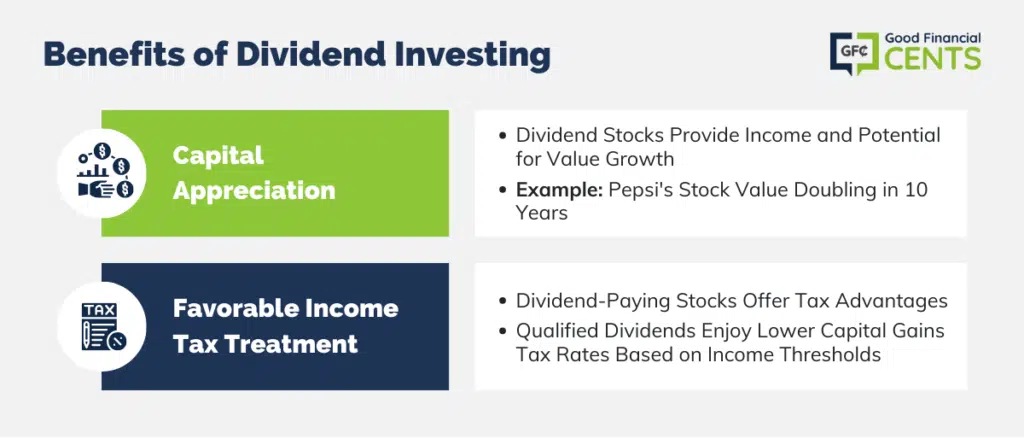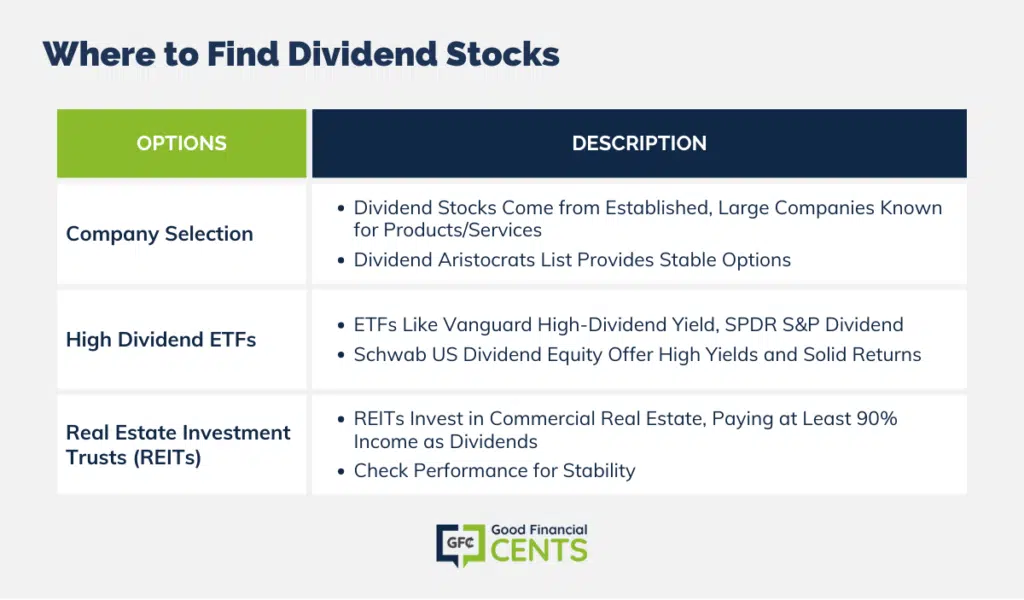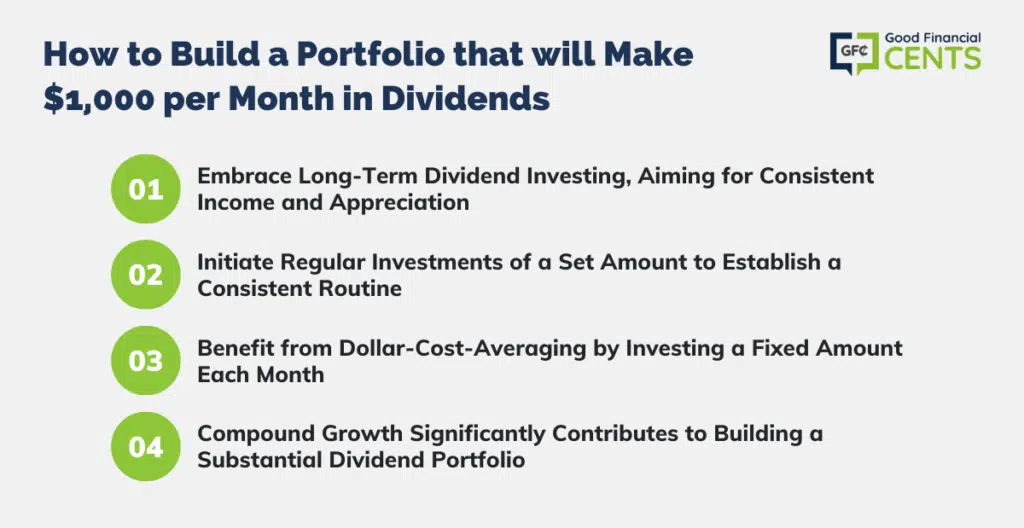There are a ton of articles on the web extolling the virtues of passive income. But, if you really take a close look, a shocking number of them aren’t truly passive income sources.
Sure, they’ll generate steady income, often while you’re busy doing other things, but you’ll have to put in at least some effort to make it happen.
Blogging is a perfect example. It’s true that it can make a whole bunch of income once it’s up and running and producing a steady cash flow.
But, a lot of work goes into building up a blog to that point. And, even once you do, you’ll still need to manage it going forward. At best, it’s a semi-passive income. It’s an excellent income source, mind you, but it’s not truly passive.
That’s why I like dividend income. It’s a true source of passive income.
Dividends – The Ultimate Source of Passive Income
Table of Contents
- Dividends – The Ultimate Source of Passive Income
- The Bonus Benefits of Dividend Investing
- Where to Find Dividend Stocks
- Sample of a Portfolio Generating $1,000 per Month in Dividends
- Dividend Schedules: Building a Portfolio to Provide a Steady Monthly Income
- Where to Invest in Dividend Stocks
- How to Build a Portfolio that will Make $1,000 per Month in Dividends
- Warning – Don’t Chase High Dividend Yields!
- The Bottom Line
Let’s start with a definition of passive income, one I think we can all agree on…
Income received without any effort on the part of the recipient.
By that definition, there are a few investments that qualify. Interest-bearing investments, like certificates of deposit and U.S. Treasury securities, are certainly an example. You’ll earn steady, predictable interest income on your investment.
The only problem is that most of these securities currently pay interest rates well below 1%.
Rental real estate is another form of passive income, but like blogging, it’s really semi-passive. After all, you’ll need to manage the property in order to produce the monthly income.
Dividend income, however, is in a class by itself, especially in this era of incredibly low-interest rates. You can create a portfolio of stocks that provides steady returns of 3%-4% per year without any effort on your part.
That’s the best example of a truly passive investment there is right now.
Sure, it requires a large amount of capital to produce the desired income level. But, once you do, you can earn a generous income—even $1,000 per month in dividends. And, once it’s up and running, you won’t have to lift a finger to make it happen.
The Bonus Benefits of Dividend Investing
1. Capital Appreciation
I’m going to be discussing mostly dividend income in this guide, but dividend stocks also have the potential to generate capital appreciation. After all, they’re stocks, and they do tend to rise in value over the long term.
Let’s take Pepsi (PEP) as an example. The stock is currently paying a dividend of nearly 3% per year. The current share price is about $173. But you could have purchased the stock 10 years earlier at less than $65 per share. That means the value of the stock more than doubled in 10 years—all while earning 3% per year for you in completely passive income.
That indicates the double-edged advantage of dividend stocks—not only do they provide steady income, but they also provide capital appreciation. That protects your investment against inflation but also enables it to grow over the long term.
That makes dividend stocks one of the very best investments you can have, and a strongly recommended foundation for your entire portfolio. You can hold other investments, but dividend stocks should represent a core holding.
Disclaimer
Dividend Stocks vs Growth Stocks
Now, I do have to make an important distinction here about appreciation. Dividend stocks typically don’t rise in price as much as growth stocks. That’s because—as the name implies—growth stocks are all about growth. They pay either little in dividends or even none at all. Instead, all profits are reinvested back into the business to expand revenue and profits.
Some of the best-performing stocks over the past decade have been growth stocks that pay no dividends at all. A good example is Amazon (AMZN). It doesn’t pay a dividend, but its stock price has increased from $170 per share 10 years ago to nearly $3,000 at the time of their 20-1 stock split in 2022. It highlights the company’s commitment to providing accessibility to its stock for a wider range of investors.
At the time of the announcement, shares were valued at $2,785, reflecting a remarkable gain of more than 4,500% since the previous split,
Though you may want to hold a number of these stocks in your portfolio, remember that you won’t get any income from them until the day you sell. That’s when you’ll get the benefit of the appreciated value. Until then, it’s just paper profit.
So, if you’re looking for passive income, dividend stocks are the better choice of the two.
2. Favorable Income Tax Treatment
In addition to paying yields well above those offered on interest-bearing securities, dividend-paying stocks also offer certain tax benefits.
Ordinary dividends are taxable as ordinary income for federal tax purposes. But, qualified dividends get the benefit of the lower long-term capital gains tax rate.
To be a qualified dividend, the stock must be issued by either a US corporation or by a foreign corporation whose stock trades on a US-based exchange. You must also own the stock for at least 60 days for the dividends paid on it to be considered qualified.
For qualified dividends, the tax rates in 2025 are as follows:
- 0% if your taxable income is $47,025 or less.
- 15% if your taxable income is greater than $47,025 but less than $518,900 if you’re single, or $583,750 if you’re married filing jointly, or a qualified widower.
- 20% if your taxable income exceeds the above thresholds.
Of course, those lowered (or nonexistent) tax rates won’t matter if you’re holding your dividend stocks in a qualified tax-deferred retirement plan. But, they’ll be a big advantage if you’re holding them in a taxable investment account.

Where to Find Dividend Stocks
Dividend-paying stocks, at least the ones that pay higher yields consistently over many years, tend to be issued by companies that are large and have established financial track records.
In most cases, they are also well known. That’s because they have either popular products or services, or they’re industry leaders that have been around for a long time. And, because of all those qualities—plus their dividends—they naturally tend to be popular with investors.
There are three basic ways to invest in dividend stocks:
Start with Dividend Aristocrats
The current average yield on all stocks in the S&P 500 index is 1.47%. You might start with zeroing in on those stocks that have even higher dividend yields.
You can certainly use stock screener software to find those companies, but there is an easier way.
There’s a list of high-dividend-paying stocks known as Dividend Aristocrats, where you can find some of the best, most stable candidates. There are currently 65 companies on the list.
There are very specific criteria for a company to qualify as a Dividend Aristocrat. The company must:
- Increase the dividend it pays to shareholders for at least 25 straight years.
- Be a large, established company, rather than a fast-growth company, and generally part of the S&P 500.
- Have a minimum market capitalization of at least $3 billion.
- Have an average of at least $5 million in daily share trading value for the three months prior to the rebalancing date.
But, just because a stock is a Dividend Aristocrat doesn’t mean it’s automatically a good investment. You should be aware that just because a company is on the list doesn’t mean it’s a permanent situation. New companies have been added to the list, while others have been dropped, in most years.
What to Watch Out For Even With Dividend Aristocrats
Two factors to be aware of even with Dividend Aristocrats are:
- The Dividend Payout Ratio. This is the percentage of a company’s net profits that are paid out in dividends. If this number approaches or exceeds 100%, the current dividend is probably not sustainable. An optimal dividend payout ratio is in the 50%-60% range.
- An Excessive Dividend Yield. The average range for the Dividend Aristocrats is a yield of between 3% and 4%. If a company pays substantially more, like 6%, 8% or more, it may be because its share price has fallen. And it can be an indication of distress.
Either situation can indicate a dividend reduction is a real possibility. If that happens, not only will your dividend yield be reduced, but the price of the stock will almost certainly fall.
High Dividend Exchange Traded Funds (ETFs)
If you don’t like holding individual stocks, you can invest in ETFs instead. There are ETFs that specialize in dividend stocks.
Examples include:
- Vanguard High-Dividend Yield ETF (VYM) – current dividend yield of 3.20%, with an overall average return of 10.45% over the past 10 years.
- SPDR S&P Dividend ETF (SDY) – current dividend yield of 2.81%, with an overall average return of 10.23% over the past 10 years.
- Schwab US Dividend Equity ETF (SCHD) – current dividend yield of 3.52%, with an overall average return of 12.61% over the past 9 years (the fund was launched in October 2011).
Do you notice that not only do all three of these funds offer current yields that are much higher than interest-bearing investments, but also show double-digit overall returns for the past decade?
These funds may not make you rich the way high-flying growth stocks will, but they provide steady reliable returns. If you’re a long-term investor, that’s the kind of investment that has to dominate your portfolio.
Real Estate Investment Trusts (REITs)
A REIT is like a mutual fund that invests in real estate instead of stocks, but not just any real estate. REITs mainly invest in commercial property, including office buildings, retail space, warehouses, large apartment complexes, and similar properties.
What’s more, they’re legally required to pay out a minimum of 90% of their income in dividends to their shareholders. That’s composed of a mix of net rental income and capital appreciation distributions from sold properties. And, to keep things simple, REITs typically pay dividends on a monthly basis.
REITs worth considering for high dividend income include the following:
- Brookfield Property REIT (BPY) – current dividend yield of 8.32%.
- Kimco Realty Corp (KIM) – current dividend yield of 2.81%.
- Brandywine Realty Trust (BDN) – current dividend yield of 7.28%.
However, be aware that the long-term price performance of REITs has not been good in recent years. Both Brookfield Property REIT and Kimco Realty Corp have seen significant declines in their share prices over the past 10 years, despite paying consistently high dividends. Brandywine Realty Trust fared the best on capital appreciation, holding flat over the past 10 years.

Sample of a Portfolio Generating $1,000 per Month in Dividends
To generate $1,000 per month in dividends, you’ll need to build a portfolio of stocks that will produce at least $12,000 in dividends on an annual basis. Using an average dividend yield of 3% per year, you’ll need a portfolio of $400,000 to generate that net income ($400,000 X 3% = $12,000).
I know you’re thinking that building a $400,000 portfolio is impossible, so why bother?
For the moment, just follow me in this section; we’ll get to building that $400,000 portfolio as the next topic.
The table below shows a portfolio—10 stocks, each with an equal investment of $40,000—that will generate more than $1,000 per month in dividend income. The stocks included are drawn from Dividend Aristocrats.
| Company (Stock Symbol) | Total Investment | Share Price as of October 30, 2020 | Number of Shares Owned | Dividend Yield Percentage | Annual Dividend Income |
| Archer Daniels Midland (ADM) | $40,000 | $46.24 | 865.05 | 2.92% | $1,168 |
| AFLAC (AFL) | $40,000 | $33.95 | 1,178.20 | 2.70% | $1,080 |
| 3M Company (MMM) | $40,000 | $159.96 | 250.06 | 3.60% | $1,440 |
| Cardinal Health (CAH) | $40,000 | $45.79 | 873.55 | 3.51% | $1,404 |
| Cincinnati Financial (CINF) | $40,000 | $70.74 | 565.45 | 2.80% | $1,120 |
| Consolidated Edison (ED) | $40,000 | $78.49 | 509.62 | 3.86% | $1,544 |
| Essex Property Trust (ESS) | $40,000 | $204.59 | 195.51 | 3.27% | $1,308 |
| General Dynamics (GD) | $40,000 | $131.33 | 304.58 | 2.99% | $1,196 |
| Genuine Parts Co. (GPC) | $40,000 | $90.43 | 442.33 | 3.21% | $1,284 |
| Coca-Cola (KO) | $40,000 | $48.06 | 832.29 | 3.12% | $1,248 |
| TOTALS | $400,000 | N/A | N/A | 3.20% (average) | $12,792 |
Why I Didn’t Include Stocks With the Highest Dividend Yield
Now, I didn’t necessarily include those companies with the highest dividend yield.
When we were discussing which dividend stocks to invest in, I listed several criteria for choosing stocks most likely to continue paying high dividends for the foreseeable future. For that reason, I’ve excluded certain stocks that might not make the cut.
For example, AbbVie has a dividend yield of 4.96%—that would look good in any portfolio, right? But, they have a dividend payout ratio of 100%, which means they’re not reinvesting in building the company. That can compromise future dividend payments.
An even more extreme example is Exxon Mobil, currently paying 9.42%. With a dividend payout ratio well over 400%, they’re a prime candidate for a dividend cut or even a dividend elimination.
Dividend Schedules: Building a Portfolio to Provide a Steady Monthly Income
If you want to receive dividends on a monthly basis, you’ll need to build your portfolio with a mix of companies paying their dividends in different months within the same quarter.
The issue is that companies pay dividends on a quarterly basis. The lone exception is REITs; they pay dividends on a monthly basis. But, due to poor long-term price performance, you certainly don’t want a portfolio filled with only REITs. That would also leave you exposed to a portfolio invested 100% in commercial real estate.
Turning back to company stocks, you want to stagger the dividend payout dates to generate a monthly income.
For example, using stocks from the sample table above, Cardinal Health pays dividends in January, April, July, and October. General Dynamics pays its dividends in February, May, August, and November. Finally, AFLAC pays its dividends in March, June, September, and December.
If you own all three stocks, you’ll receive monthly dividends based on the following schedule:
- January – Cardinal Health
- February – General Dynamics
- March – AFLAC
- April – Cardinal Health
- May – General Dynamics
- June – AFLAC
- July – Cardinal Health
- August – General Dynamics
- September – AFLAC
- October – Cardinal Health
- November – General Dynamics
- December – AFLAC
It isn’t necessary to stagger company dividend payouts in your portfolio. You only want to do that if you absolutely need a monthly income. But, because each company pays dividends at a different rate, it will be very difficult to come up with a mix of stocks that will produce exactly $1,000 in income each month. However, it is possible.
The alternative is to ignore payout dates, sweep your dividends for each quarter into a cash account, and pay yourself a monthly average of the quarterly total.
Where to Invest in Dividend Stocks
You can invest in dividend stocks or high-dividend ETFs through any of the following investment platforms. Best of all, each allows you to invest in either stocks or ETFs commission-free.
Webull
Webull works very similarly to Robinhood. It offers commission-free trading of stocks, ETFs and options, and it is optimized for mobile trading. It’s the perfect platform for an investor who’s constantly on the go.
Webull requires no minimum initial investment to open an account, though you will need funds to invest. And, one advantage it does have over Robinhood is that it offers both traditional and Roth IRA accounts. That’s important because a dividend stock portfolio emphasizes both long-term growth and income, both of which make them a natural fit for retirement accounts.
Webull also pays interest on any invested cash held in your account.
M1 Finance
M1 Finance works similarly to Robinhood and WeBull, except that rather than buying and holding individual stocks, you’ll instead purchase them through portfolios they refer to as “pies.” Each pie is composed of as many as 100 stocks and/or ETFs.
Though they offer pre-built pies, you can design your own and fill it with the stocks and ETFs of your choice. That means you can create a pie composed entirely of 10, 15, or 20 of your favorite Dividend Aristocrats, or even choose all 65 on the list. There is no limit on the number of pies you can create. You can create one holding Dividend Aristocrats, and others holding growth stocks or even specific sector ETFs—it’s your choice.
The advantage with M1 Finance is what happens after you’ve created one or more pies. The app will manage your pie robo-advisor style, handling periodic rebalancing to keep your allocations on target, and even reinvesting dividends. That means once you’ve chosen the stocks or funds in your pie, you can relax and watch your investment grow.
It’s passive investment income at its best!

How to Build a Portfolio that will Make $1,000 per Month in Dividends
This is a big hurdle for new and small investors. After all, to make $1,000 per month in dividends, you’ll need about $400,000 with an average yield of 3%.
But, how do you reach $400,000?
Let’s start with a little bit of perspective. Dividend investing is long-term investing to the core. You’re not investing for growth—certainly not explosive growth—but for a steady income and, hopefully, a decent amount of appreciation along the way. That means you’ll need to think of it as a long-term investment, which requires both patience and consistent investing.
Start by deciding how much you plan to invest and do it on a regular basis. For example, you can choose to invest $500 per month, or even buy 10 shares per month of a particular stock.
As you go forward, you can gradually increase your investment contributions, eventually reaching the point where you’ll be adding many thousands of dollars each year.
That actually works out to be a good thing. Since you’ll be buying a little bit each month, you’ll be dollar-cost-averaging. That’s the best way to invest since it virtually ignores stock price or any end-of-market timing. You’ll just be investing the same amount each and every month.

The Magic of Compounding to the Rescue
For example, let’s say you invest $500 per month—$6,000 per year—in a growing portfolio of dividend stocks with an average return of 10%, including both dividends and capital appreciation.
Even if you never increase the amount you invest, you’ll have slightly over $400,000 in your dividend portfolio in 21 years. If you do increase your monthly contributions, you will reduce the number of years it will take. It all depends on how determined you are to build a true passive income portfolio, as well as the extra cash you have available to invest each month.
Now, an important part of this long-term growth strategy will be the reinvestment of dividends. During the time you’re building your dividend portfolio, you won’t be taking any income. Instead, you’ll use any dividends received to buy more shares of the companies you’re investing in.
This can easily be done through what is known as Dividend Reinvestment Plans, commonly known as DRIPs. They can often be set up through the broker where you hold the stock. By participating in a DRIP, dividends will automatically be used to buy more stock in the same company.
The combination of regular contributions, reinvestment of dividends, and capital appreciation will be the power behind the compounding that enables you to build a portfolio large enough to generate $1,000 per month in dividends.
Warning – Don’t Chase High Dividend Yields!
It’s very easy to fall into thinking that goes something like this: if high dividends are good, higher dividends are even better.
In reality, the opposite is true. If any entity is paying significantly more than 3% or 4%, the risk of owning it will increase.
Earlier, I touched on how companies paying excessive dividends, or dividend payouts that exceed their net income, could be headed for trouble, and it’s worth repeating. If the company’s dividend yield is excessive, there’s an excellent chance they’ll cut the dividend, which will almost certainly collapse the share price.
Similarly, step lightly with master limited partnerships (MLPs). These are publicly traded partnerships that invest primarily in energy-related businesses and real estate since both groups have been providing high dividend yields. But, these partnerships are not only invested in highly speculative sectors, but they’re also often highly leveraged.
Put another way, high dividend yields may mask underlying weaknesses.
Another source of potential high-yield dividends are closed-end funds, so-called because the fund cannot issue any new shares. But, that means the price of a share will rise or fall—sometimes dramatically—based on investor interest or the lack of it. The share price may not match—or even come close to—the net asset value of the fund.
An even bigger potential problem is the ability to sell a closed-end fund, based on finding a willing buyer on the market. Unlike ETFs, the fund will not automatically buy back any shares you want to liquidate.
The attraction of closed-end funds is that they often pay high dividend yields. But, the risks associated with them, just like with stocks with excessive yields or MLPs, make them less reliable over the long term.
The Bottom Line
Dividend stocks aren’t as glamorous as growth stocks. But, they’re the kind of investment that will build both permanent wealth and the kind of income you can earn by doing absolutely nothing. Who doesn’t want that kind of income?
Dividend stocks are especially attractive for retirement portfolios. Not only do they offer a reliable way to build wealth over decades, but they also provide a steady stream of income once you reach retirement. You can take the 3%-4% in dividend income for living expenses, while the stock prices rise in value over time—perfect!
And, though I’ve been talking about $1,000 per month in dividend income, you can choose whatever number you want: $2,000, $3,000, even $5,000.
Sure, that’ll take a much larger portfolio. But, if your plan is to become wealthy, or to retire with a seven-figure portfolio, you may as well make a generous income while you do.







